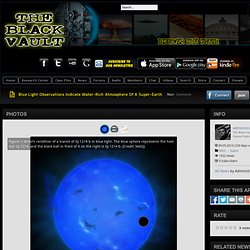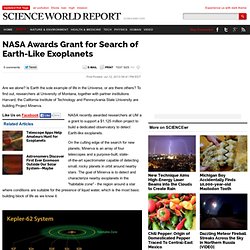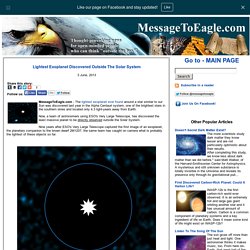

Blue Light Observations Indicate Water-Rich Atmosphere of a Super-Earth. ** Please note, all images above copyrighted to Subaru Telescope ** A Japanese research team of astronomers and planetary scientists has used Subaru Telescope's two optical cameras, Suprime-Cam and the Faint Object Camera and Spectrograph (FOCAS), with a blue transmission filter to observe planetary transits of super-Earth GJ 1214 b (Gilese 1214 b).

The team investigated whether this planet has an atmosphere rich in water or hydrogen. The Subaru observations show that the sky of this planet does not show a strong Rayleigh scattering feature, which a cloudless hydrogen-dominated atmosphere would predict. When combined with the findings of previous observations in other colors, this new observational result implies that GJ 1214 b is likely to have a water-rich atmosphere. Current theory posits that a planet develops in a disk of dense gas surrounding a newly formed star (i.e., a protoplanetary disk). References: Acknowledgements: This research was supported in part by the following:
NASA Awards Grant for Search of Earth-Like Exoplanets. First Posted: Jul 12, 2013 06:41 PM EDT Are we alone?

Is Earth the sole example of life in the Universe, or are there others? To find out, researchers at University of Montana, together with partner institutions Harvard, the California Institute of Technology and Pennsylvania State University are building Project Minerva. Like Us on Facebook NASA recently awarded researchers at UM a a grant to support a $1.125 million project to build a dedicated observatory to detect Earth-like exoplanets. On the cutting edge of the search for new planets, Minerva is an array of four telescopes and a purpose-built, state-of-the-art spectrometer capable of detecting small, rocky planets in orbit around nearby stars. (Photo : NASA/JPL-Caltech)The diagram compares the planets of the inner solar system to Kepler-62, a five-planet system about 1,200 light-years from Earth.
The team currently is evaluating host sites for the telescope and plans to select one this coming fall. Une exoplanète bleue comme la Terre identifiée. HD 189733b © afp. article source: 7sur7.be/ via wikistrike.com D’un bleu cobalt profond, sa couleur rappelle celle de la Terre vue de l’espace : pour la première fois, des astronomes utilisant le télescope spatial Hubble ont réussi à déterminer la vraie couleur d’une exoplanète.

Mais la ressemblance s’arrête là: situé à 63 années-lumière de notre Planète bleue (soit 600.000 milliards de km), dans la constellation du Petit renard, cette exoplanète appelée HD 189733b est une géante gazeuse, parfaitement inhospitalière, en orbite très près de son étoile hôte. Son atmosphère changeante est torride, avec une température de plus de 1.000 degrés Celsius. Elle est balayée par des vents soufflant à 7.000 km/heure et "il y pleut du verre", selon un communiqué de l’Agence spatiale européenne (ESA). Pour déterminer sa couleur, les astronomes ont mesuré la quantité de lumière réfléchie par la surface de HD 189733b, une propriété appelée "albédo". Source Like this: J'aime chargement…
Lightest Exoplanet Discovered Outside The Solar System. Subscribe in a reader Other Popular Articles Doesn't Secret Dark Matter Exist?

The more scientists study dark matter they know lesser and are not particularly optimistic about their results. After completing this study, we know less about dark matter than we did before," said Matt Walker, of the Harvard-Smithsonian Center for Astrophysics. A mysterious and still unknown substance is totally invisible in the Universe and reveals its presence only through its gravitational pull... First Discovered Carbon-Rich Planet: Could It Harbor Life? WASP-12b is the first carbon-rich world ever observed. Listen To The Song Of The Sun The sun gives off more than just heat and light. Huge Superflare In The Crab Nebula The famous Crab Nebula supernova remnant has erupted in an enormous flare five times more powerful than any flare previously seen from the object. Abnormal Star Discovered In The 'Forbidden Zone'